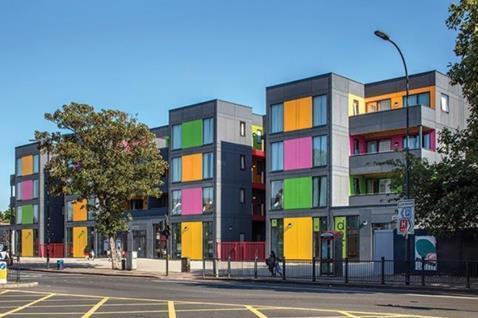Answer to homelessness lies in providing good-quality, appropriately located and sized properties, say experts

Despite their advantages in housing homeless people, temporary offsite-built homes were in danger of becoming a mere “sticking plaster” to deal with the country’s housing crisis, a new report claims.
Experts from University of London, Oxford Brookes University and Goldsmiths College examined Place/Ladywell (pictured), an award-winning development in Lewisham, south-east London, which provides temporary housing for homeless families.
The academics said the scheme should be used as a model for permanent homes to be built, but also warned that “without providing permanent housing too, developments like Place/Ladywell run the risk of just being a better ‘sticking plaster’ for the problems of the housing crisis.”
Their report – Temporary Homes, Permanent Progress? – argued that such schemes wouldn’t on their own “solve the problem of providing residents with good quality, appropriately located and sized properties in the long term”.
Designed by Rogers Stirk Harbour + Partners for Lewisham council, Place/Ladywell was built on the site of an old swimming baths complex two years ago and consists of prefabricated modules housing 24 families.
The Place/Ladywell development was an example of how “offsite manufacturing techniques can be used to provide durable, high-quality housing rapidly and we argue this should be extended to include the provision of permanent accommodation,” the report said.
Report co-author Professor Katherine Brickell of Royal Holloway said: “Our report flags our concern that projects like Place/Ladywell can only make a temporary difference to residents’ lives.
“While an improvement on other temporary accommodation, it won’t on its own solve the problem of providing residents with good quality, appropriately located and sized properties in the long term. Permanent social housing needs to be built.”
Responding to the report a Lewisham council spokesperson said the Place/Ladywell scheme was an example of what the borough could do “to tackle the consequences of homelessness caused by the housing crisis.
“It was designed as an ambitious meanwhile-use of a vacant space to take families out of poor quality, expensive B&B accommodation and give them stable, secure and high-quality temporary homes while we support them to find permanent housing.
“The community aspect of the development means there are additional social benefits for residents, especially as B&B accommodation can leave families feeling isolated,” the spokesperson added.
A spokesperson for London Councils, the cross-borough group which is promoting the roll-out of modular housing across the capital, said London was experiencing “the most severe homelessness crisis in the country”, with 55,000 households living in temporary accommodation. Boroughs also faced the challenge of a chronic lack of suitable temporary accommodation for homeless families in their local area, it said.
“Investing in purpose-built, high-quality modular housing as temporary accommodation is one part of the solution. Modular housing can provide a much-needed boost to the range and quality of accommodation options for Londoners needing a temporary home and makes use of local sites that would otherwise remain unused in the short to medium term.”
London Councils believed the best way to bring down homelessness was by addressing the city’s shortage of social housing, the spokesperson added: “That’s why boroughs are calling for more powers and funding from the government so that we can build new council homes on a major scale.”











No comments yet